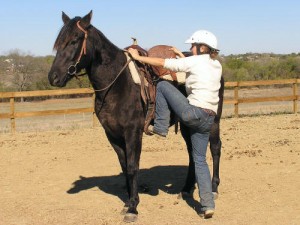 A lot of horses have trouble standing still for a rider to get into the saddle. For most of them, the real problem is that they have never been taught to stand. Some horses never develop the problem, but if your horse is one that just won’t wait for you to mount up, here are some things you can do to remedy this bad habit.
A lot of horses have trouble standing still for a rider to get into the saddle. For most of them, the real problem is that they have never been taught to stand. Some horses never develop the problem, but if your horse is one that just won’t wait for you to mount up, here are some things you can do to remedy this bad habit.
A trainer friend of mine, Kevin Wescott, has given me some really good advice. He says that you work with the horse on a lunge line or a round pen and pick the spot you want the horse to stand, whether it is at your side or next to a mounting block. Position the horse where you want him, and ask him to “whoa” and stand. If he moves, instantly lunge him at a trot in a few circles around you, then slow him and position him in the exact same spot you asked him to stand still. Again, ask him to “whoa” and stand. If he moves from that spot, repeat the process.
The more times you repeat it and he continues to move, the more you should really make him hurry and get back to the spot where he is to stand. When he is standing still correctly, speak softly to him, pat him, let him relax and enjoy being there and not being bothered. You can pet him, walk all around him, brush him, and start to step up into the saddle. If he moves, immediately make him trot and work quickly around the circle back to the spot where he is supposed to stand. Keep your movements soft and encouraging as long as he is standing still. When he moves away from his spot, change to a driving body language and use a lunge whip if necessary to really get him to move out and trot away from you, moving him around a large circle to get back to his spot. This will teach him to stand when you ask him to.
If you do get into the saddle without him moving, pet him, talk encouragingly to him, and get back off and end that lesson for the day. This will reward him for doing the right thing, and you can take up the lesson again the following day. He might need a refresher now and then to remind him to stand still, but if he knows you will consistently make him work if he doesn’t obey, he will always take the easy route, which is to stand quietly while you get into the saddle.
If you are a Clinton Anderson follower, you will recognize this method as the “Lungeing for Respect” exercise he teaches. It is basically the same thing, only Kevin Wescott has been around a lot longer than Clinton, and Kevin is quite a bit more gentle on his horses than Clinton would be. But the main idea is the same: Ask the horse for a certain action (or in this case, to stand still), and if he moves, then move him faster and with more energy than he really wanted to spend. This uses the horse’s own lazy nature and self-preservation instincts to train him to do what you asked of him.
Growing up, I always used the inside rein when I mounted up, and if the horse took a step, I pulled just the inside rein to tip him in a close circle around me, and would try to keep my foot in the stirrup and make the horse circle around me while I went ahead and got on. Usually a horse pulled in a tight circle will eventually stop, so if you do this with consistency, the horse will generally learn to stand still whenever you go to get on. Some horses will really fight it though, and for the tough ones, I suggest the first method.
It is a good practice to always ask a horse to stand for a moment when you first get on. In the old Western movies, you saw cowboys dashing to their horses and leaping into the saddles while their horse went into a dead run. Let’s just say that might have looked fancy, but nobody needs that kind of careless speed these days! If your horse is in the habit of walking off as you are putting your foot in the stirrup, ask him to “whoa” and then take a few steps back. Keep him there, pet him a little, and discourage him from rushing off when you are mounting. It will help put your horse in a mindframe to listen for your direction, rather than going off at his own whim while you are still getting settled.
There are always little things we can improve on our horses, and if this is one thing that your horse needs work on, try these methods for a couple of days in a row. You will be surprised at how your horse responds, if you are consistent. It will result in a much safer, more obedient, and more in-tune horse.

